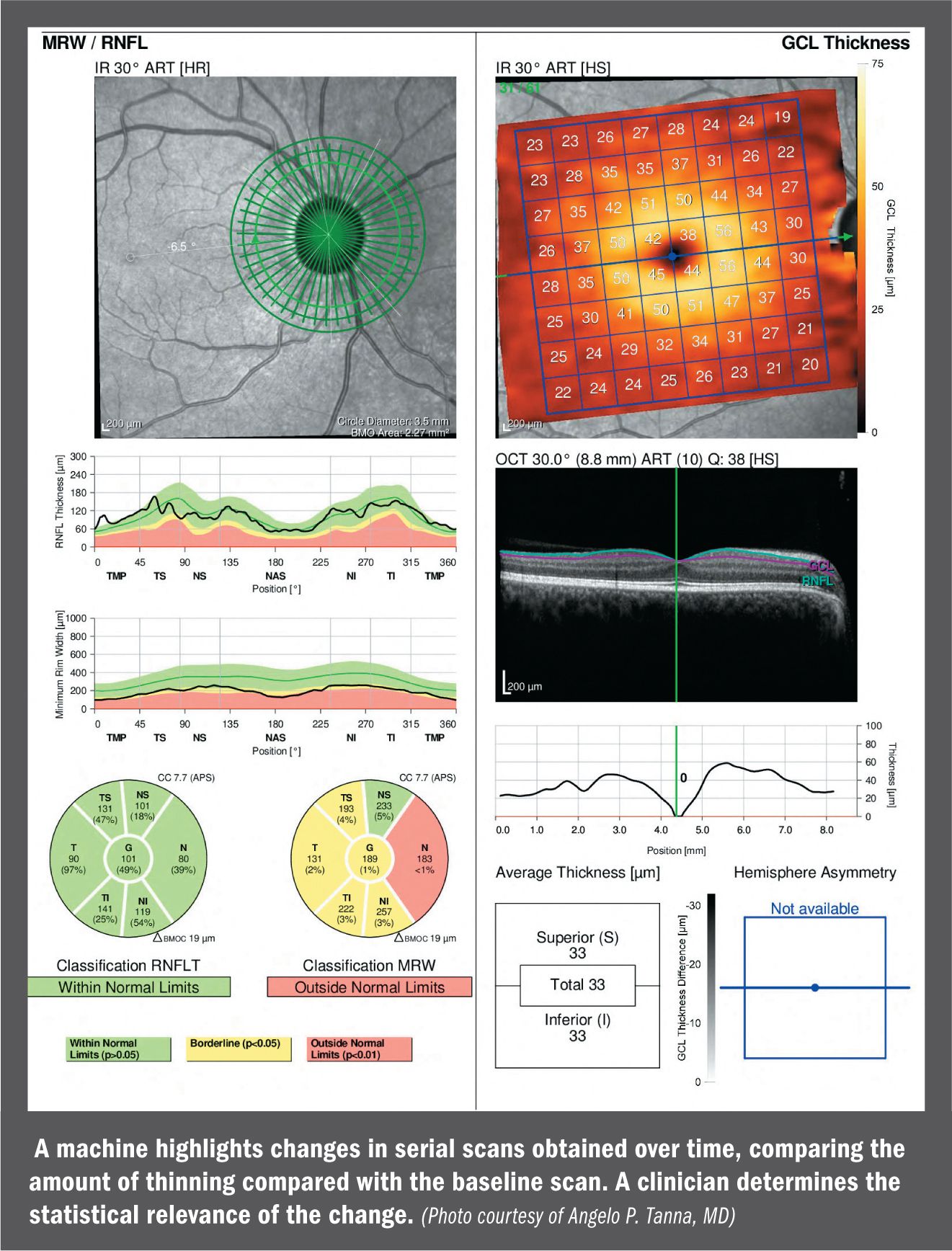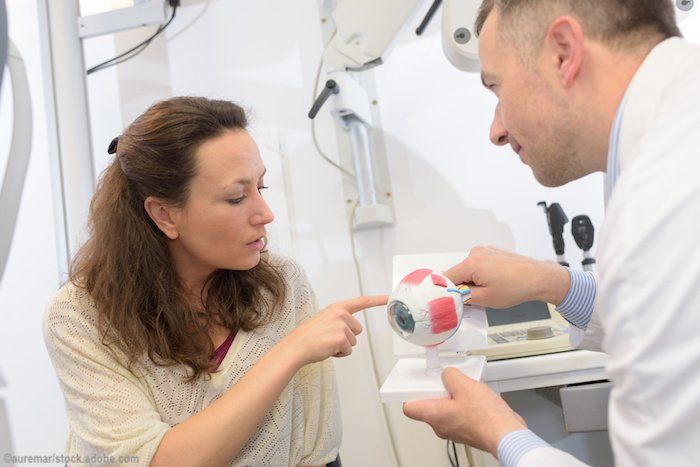News
Article
Technology assisting surgeons in capturing spectral-domain OCT
Author(s):
Common devices differ in hardware, analysis, and display of data


Among the three most popular optical coherence tomography and angiography devices, there are important differences in hardware, resolution and the manner in which the data are analyzed and displayed.
Reviewed by Angelo P. Tanna, MDSpectral-domain optical coherence tomography (SD-OCT) technology has been progressively advancing in recent years. In the United States, some commonly used instruments are currently manufactured by Optovue, Inc., Heidelberg Engineering, and Carl Zeiss Meditec.
While these are common devices, the features among them differ, according to Angelo P. Tanna, MD, vice chairman and associate professor of ophthalmology and director of the Glaucoma Service, Northwestern University Feinberg School of Medicine, Chicago.
OCT instruments
For example, the Cirrus 5000 SD-OCT system from Carl Zeiss Meditec has two different detectors that operate at different scan speeds, i.e., 27 mHz for OCT imaging and 68 mHz for OCT angiography (OCTA).
Dr. Tanna said he believes that these differences in scan speed and resolution among the different SD-OCT platforms result in differences in the quality of the images.
He demonstrated that the Spectralis OCT2 system from Heidelberg Engineering has exceptional image quality and very high effective resolution because its 85 mHz scan speed allows multiple scans can be obtained and averaged and results in reduced motion artifact.
Normative databases are important. All of the instruments have robust ethnically diverse normative data. However, a drawback for all of the OCT devices is that a comparison of a specific patient to his or her ethnic group within the database is not possible.
Patients are compared to an age-similar group of norms, Dr. Tanna noted. Another difference is the manner in which the macular thickness is measured among the instruments.
“For clinicians interested in this parameter, this is an important difference to recognize among these machines,” he said.
When evaluating macular thickness for glaucoma diagnosis and monitoring, the Cirrus instrument reports the thickness of the ganglion cell layer and the inner plexiform layer (GCIPL).
The instrument (Avanti, Optovue) reports the ganglion cell complex (GCC), that is, everything from the internal limiting membrane to the inner plexiform layer. The Spectralis instrument can measure and report the entire macular thickness or the thickness of individual retinal layers in the macula-the retinal nerve fiber layer (RNFL), ganglion cell layer, or inner plexiform layer.
Cirrus offers a robust method for evaluating serial macular GCIPL or peripapillary RNFL scans for the detection of progression. The Avanti and Spectralis devices also offer methods of evaluating serial scans for progression detection; however, at present the clinician must determine whether an observed change is statistically meaningful.
The Cirrus optic nerve head and RNFL analysis printout includes an RNFL heatmap, the thickness deviation of the RNFL compared to the normative database, and tomograms that should be reviewed for segmentation errors or other artifacts.
The Ganglion Cell Analysis printout includes a heatmap of the GCIPL thickness, the deviation of the GCIPL thickness compared to the normative database, and one SD-OCT tomogram through the macula that should be reviewed for artifacts. This can sometimes disclose pathology such as macular edema or an epiretinal membrane that may have been missed clinically.
“The great power of the Cirrus instrument, in my opinion, is the methodology and analytics for looking at disease progression,” he said, and demonstrated the nerve fiber layer and the macular thicknesses obtained at different time points in a patient whose disease worsened over time.
“Most importantly, the instrument provides an analysis that facilitates complex comparisons between the current and previous scans,” Dr. Tanna explained. “The instrument also provides rates of change of various index averages and compares the thickness profiles along a 3.4-millimeter circular scan.”
The Spectralis OCT2 printout includes a confocal scanning laser ophthalmoscopy image of the posterior pole; a heatmap of the macular ganglion cell layer thickness (or a choice of other retinal layers); and the RNFL thickness profile along a 3.4-millimeter circular scan centered on the optic disc.
Other data
Other reported data are the minimum rim width along the Bruch’s membrane opening (BMO-MRW) and numerical and color-coded graphical comparisons of sectors in the RNFL and BMO-MRW with the normative database.
Regarding changes in serial scans obtained over time, the machine highlights the changes and the amount of thinning compared with the baseline scan, but the clinician must determine the statistical relevance of that change.
For all the instruments, the clinical relevance of any detected change must be determined by the ophthalmologist. There are different ways of generating reports when using the Avanti instrument.
An effective approach is to include a heatmap of the RNFL and a deviation map of the macular compared to the normative database along with color-coded graphical comparisons of the 3.4 mm circumpapillary RNFL profile and sectors with the normative database.
The analytics for change over time provide various displays including, for example, heatmaps of the GCC and RNFL thickness and linear regression analyses of the rates of change over time.
The instrument is also capable of providing a change analysis compared to the normative database for the macular GCC, Dr. Tanna pointed out.
OCTA All of the previously mentioned devices have OCTA capability; however, regarding pricing, for each instrument OCTA is an add-on feature. The big difference among the devices, Dr. Tanna noted, is that analytics relevant to glaucoma are only available with the Avanti device.
Conclusion
“All devices have strong evidence-based support for the concept that the changes seen in structure particularly that of the RNFL, are predictive of future visual field changes,” he said. Dr. Tanna noted that the Cirrus analytics, particularly for progression, are very strong.
“For Avanti, the OCTA analytics are very powerful and we do not have meaningful glaucoma-relevant analytics for the others,” Dr. Tanna concluded. For the Spectralis, the scan speeds are very high, resulting in superior effective resolution.”
Disclosures:
Angelo P. Tanna, MD
E: atanna@northwestern.edu
This article is based on Dr. Tanna’s presentation at the American Glaucoma Society 2019 annual meeting in San Francisco. Dr. Tanna is a consultant to Carl Zeiss Meditec
Newsletter
Don’t miss out—get Ophthalmology Times updates on the latest clinical advancements and expert interviews, straight to your inbox.




